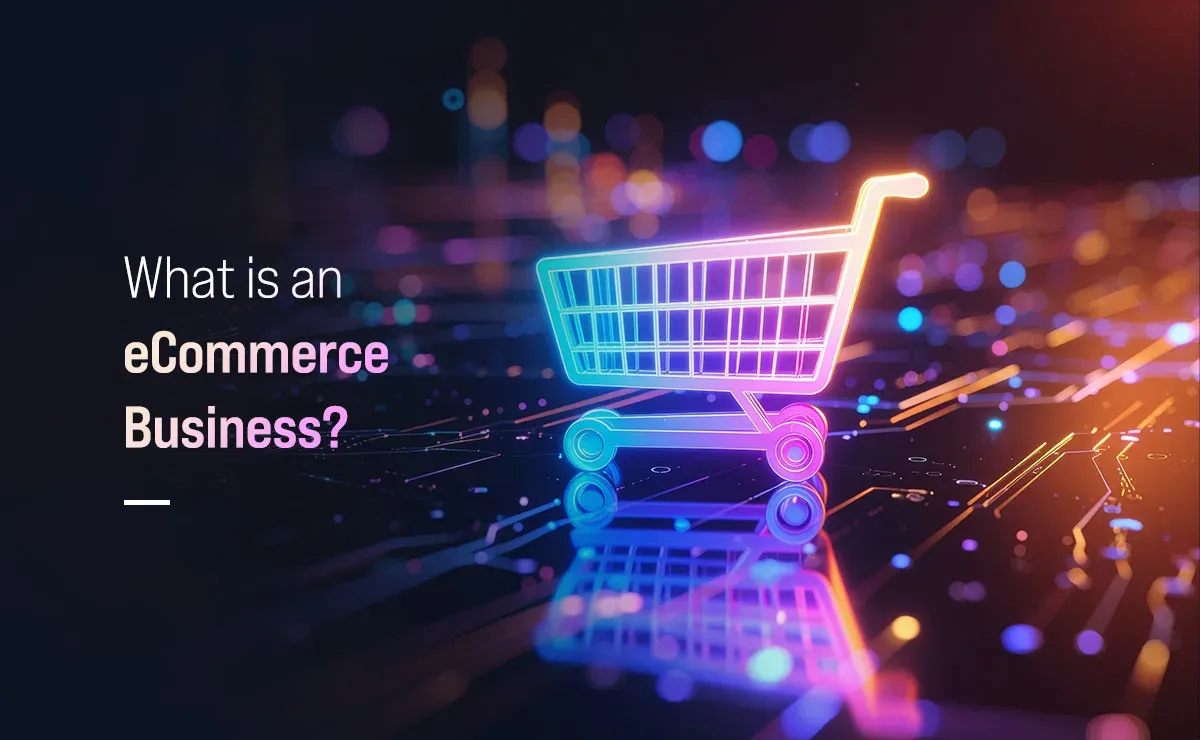How to Start an eCommerce Business in India?

The eCommerce industry in India is growing. It offers aspiring entrepreneurs the opportunity to launch successful online businesses. It is revolutionizing the way goods and services are sold, primarily online. Fueled by a rising number of internet users and greater smartphone accessibility, launching an eCommerce business has never been easier.
Launching an eCommerce venture in India can lead to both personal satisfaction and monetary success when backed by solid planning and industry insight. The article will also focus on practical tips and strategies for new entrepreneurs looking to break into this market.
What is an eCommerce Business?

An eCommerce platform functions as a virtual marketplace where buyers and sellers can exchange products and services through internet-based transactions. It enables transactions between businesses, consumers, or government entities. It is revolutionizing traditional retail by allowing global, 24/7 commerce.
E-Commerce has made access easy for both customers and sellers. Customers shop and choose goods and services, make purchases, and pay with the help of safe online systems. The back-end systems, such as the inventory, payment gateways, and logistics services, process the orders in real time to achieve timely and accurate order fulfillment.
Leading online retail platforms like Amazon and Flipkart offer comprehensive tools to help businesses establish, manage, and expand their digital storefronts, enabling companies of all sizes to operate in online retail.
5 Key Takeaways of an eCommerce Business:
- Convenience and Accessibility: eCommerce allows businesses to reach customers globally. This provides shoppers with a seamless experience available 24/7 from any internet-connected device, regardless of location.
- Personalized Shopping: E-commerce enables businesses to customize the shopping journey by leveraging data-driven insights. This leads to targeted recommendations, promotions, and increased customer loyalty.
- Lesser Barriers to Entry: The online platform considerably decreases the start-up expenses. This provides an entryway for small businesses and upcoming entrepreneurs to start and expand rapidly.
- Integrated Payment and Fulfillment: eCommerce relies on streamlined digital processes, including secure payment gateways and efficient inventory management. This helps businesses manage orders accurately and fulfill them promptly.
- Data-Driven Insights: eCommerce operations can access essential customer data and analytics, providing insights into purchasing habits that help shape marketing strategies and growth decisions.
Advantages of an eCommerce Business Start-up
The advantages of launching an eCommerce venture are many, especially in digitally progressive economies such as India.
1) Accelerated Purchase Process:
The simplicity of the eCommerce business model facilitates the purchasing process by providing customers with a seamless online experience that lets them shop, compare, and buy at the same time.
As opposed to physical stores, online shopping provides the advantage of having everything available in one place, and it is a faster and more efficient way of shopping. This has resulted in the customer being more satisfied, which causes fewer abandoned carts and higher sales.
2) Dynamic Product Listings:
The ability to establish rich and flexible product descriptions and displays is one advantage of online retail. The sellers have an opportunity to include detailed descriptions, quality photographs, customer reviews, and video displays. All relevant information about the product and specifications is available to shoppers, and they can make their purchase decisions.
Such platforms enable removing doubts and concerns among buyers by encouraging transparency and openness in transactions. Besides, companies are able to refresh the list of products in real-time to display new ones, offer discounts, and make their online shop more attractive.
3) Low Startup Costs:
In comparison to the conventional brick-and-mortar shops, an online business will cost a lot less initial capital to set up. Online businesses reduce rent, power charges, and maintenance expenses by avoiding the necessity to have physical premises.
The low start-up costs make online selling especially appealing to entrepreneurs who operate with limited funds. In case you are wondering how you can jump into an eCommerce business with no funds, there are other alternatives, such as dropshipping and affiliate marketing, which can save you a lot of money in the initial stages. The low financial obligation will reduce possible losses, which makes it an attractive option among first-time business owners.
4) 24/7 Availability:
eCommerce platforms cater to customers across different time zones at any time. This 24/7 availability ensures that shoppers can make purchases at their convenience.
It also increases sales, as businesses are not restricted by traditional store hours. Continuous operation enables eCommerce businesses to capture a larger share of the market by catering to both domestic and international customers.
5) Access to a Large Market:
eCommerce can reach a vast global customer base without the need for multiple physical stores. Merchants can market and distribute their offerings to a global consumer base, providing unprecedented market access previously reserved for larger corporations.
The availability of huge markets creates business opportunities, which can enable even niche products to have loyal customers. An international marketplace enables businesses to compete on a much larger scale than in a local market environment.
6) Data Insights
Online stores produce important business analytics and consumer behavior. This information can be used to learn about the consumer preferences, behavior, and buying patterns, and more comprehensive insights can be achieved with solutions such as Google Analytics and built-in reporting functionality. They can help businesses to monitor popular products, keep track of trends, and measure the rate of conversion.
The sellers are able to polish their marketing, optimize products to the maximum, and improve customer interaction, resulting in better decision-making, increased satisfaction, and higher sales.
7) Rapid Market Trend Adaptation
eCommerce companies are able to keep up with market shifts and consumer choices in a short time. Sellers are able to update product listings, change prices, and initiate promotions instantly.
This responsiveness enables the businesses to act fast in regard to changes in demand or seasonal patterns, therefore remaining competitive. E-commerce businesses can evolve with the times, regardless of whether it is fashion or a change in consumer behavior.
8) Multiple Payment Options
eCommerce offers a variety of payment methods such as credit cards, UPI, bank transfers, wallets, and installment payments, among others, and serves a wide range of customers. This ensures that the checkout process becomes very convenient.
Multiple payment options reduce cart abandonment and enhance the customer experience. Customers appreciate having a choice in how they pay, and catering to that leads to higher conversion rates and increased sales.
Types of Online eCommerce Business with Examples
The knowledge of the various models of eCommerce will assist you in determining the format best applicable in achieving the objectives of your business:
1) Business-to-Business (B2B):
This model is associated with business-to-business interaction, where companies are selling and buying items and services. Indiamart and Ninjacart are examples of a B2B business. These organizations act as wholesalers, distributors, or manufacturers, and they usually sell in bulk to other companies.
It is common in industries where suppliers provide raw materials, parts, or professional services to retailers, manufacturers, or other businesses. B2B eCommerce platforms streamline business connections, negotiations, and trade.
2) Business-to-Consumer (B2C):

B2C connects businesses directly to individual consumers, making it widely recognized in online retail. Businesses sell goods or services to end-users through online stores, apps, or digital marketplaces. Customers benefit from a wealth of product information, fast delivery, and competitive prices.
The presence of industry leaders like Amazon and Flipkart has reshaped the digital commerce industry. They provide consumers with easy access to a broad spectrum of dynamic products. Online shopping is a smooth process because of detailed descriptions and secure transactions.
3) Consumer-to-Consumer (C2C):
C2C allows people to sell their products or services to other shoppers through intermediary platforms. Examples of this model are platforms such as OLX and Quikr. They enable consumers to sell and buy used or second-hand goods without a business intermediary.
C2C marketplaces match sellers and buyers and handle money, feedback, and communication to ensure the safety of transactions. This is an ideal model when it comes to selling personal items or handmade products to customers who want to get cheap or unique products.
4) Consumer-to-Business (C2B):
The C2B model flips traditional commerce on its head, enabling individuals to provide services to companies, as seen in freelance marketplaces like Upwork. Sites like iStockphoto are also a good example, where consumers sell media assets, such as photos, to businesses.
C2B is popular in the creative and tech industries. Companies often source customized designs, photos, and other assets from individual creators. This model gives businesses access to a large pool of talent and creative assets, often in a competitive and efficient marketplace.
5) Consumer to Administration (C2A):
C2A eCommerce enables one to communicate electronically with a government service and the general administration. This model includes education, health, taxes, and social security, where consumers are able to obtain information, make payments, or request online. Examples of services are filing tax returns, making medical appointments, or accessing learning materials.
Umang App is the most widespread C2A platform in India, and provides an extensive selection of government services through one app. C2A platforms have made government services easily reachable, transparent, and convenient in civic participation and administrative dealings.
6) Business-to-Administration (B2A):
The B2A eCommerce model involves transactions between businesses and government institutions. Companies can use it for online interactions with public administrations for licensing, procurement, tax compliance, and tenders. This is crucial for public-sector contracts, where businesses bid on projects or supply goods to government agencies.
OpenGov is a B2A platform that simplifies government operations with cloud-based tools for budgeting, accounting, reporting, and licensing. Digital B2A platforms help companies manage regulations efficiently and access public-sector opportunities.
How to Start a Successful eCommerce Business?
Below is a step-by-step guide for launching a thriving eCommerce business in India.
1) Identify a Profitable Niche:
The most important and significant role in launching an eCommerce business is to identify a profitable niche. A niche is a specific segment of the market that satisfies a certain need or meets the needs of a specific group. This is a niche market that caters to a specific need or audience, which enables you to be unique, create a personalized experience, and minimize competition.
To find a niche with strong demand but minimal saturation, analyze market trends, identify customer challenges, and find gaps in existing offerings. Consider your passion and expertise as well to increase your chances of success.
2) Choose the Right eCommerce Platform:
Different platforms in eCommerce should be chosen to develop and grow your business. Shopify, Amazon, and Flipkart are platforms that provide different features that are easier to use when setting up and managing your online store.
When choosing a platform, evaluate factors like ease of use, designability, payment provisions, scalability, and customer care. Amazon is also a great place to enter, as the site is simple to navigate and has strong functionalities. Your decision should reflect the nature of your products and business objectives.
3) Source or Create Your Products:
Finding the way to stock or manufacture your products is a key aspect of the eCommerce process. Dropshipping, manufacturing your own goods, or cooperating with wholesalers are some of the methods. Dropshipping is the selling without inventory, and custom product making is a value creation.
Wholesaling enables you to buy products in bulk at discounted prices, which you can resell at a high price to make a profit. Whatever approach you take, make sure that your products are of high quality and address your target market.
4) Build a User-Friendly Website:
A digital commerce site functions as your business's virtual headquarters and primary point of sale. The website must be user-friendly, visually appealing, and responsive across desktops, tablets, and smartphones. Focus on UX by ensuring a well-designed website that aligns with your branding and makes browsing, searching, and purchasing easy.
Essential features like secure payments, customer reviews, clear product descriptions, and a simple checkout process are crucial. Developing a website that embodies your company's core principles helps establish credibility with potential customers.
5) Develop a Strong Brand Identity:
Branding plays a crucial role in setting your business apart from competitors. To build a strong brand identity, consider your values, mission, and the narrative behind your products. Your brand should connect with your target market and evoke emotions that drive customer loyalty and repeat purchases.
This process includes designing an unforgettable logo, selecting a consistent color palette, and developing engaging messaging. Robust branding cultivates customer trust, increasing the likelihood that they’ll choose your products over competitors’ offerings.
6) Set Up Effective Marketing Strategies:
The key to success in online retail is the ability to employ a successful marketing strategy where natural and sponsored channels are used to reach your target audience. Begin by implementing SEO best practices to enhance your visibility in search results.
Content marketing (blogs, social media, videos) can increase brand visibility and audience engagement. Paid advertising (Google Ads, Facebook/Instagram ads) can generate immediate sales. In addition, influencer marketing can extend your reach, especially within niche markets.
7) Focus on Customer Experience:
Customer experience (CX) is vital to the success of any eCommerce business. Positive experiences lead to repeat purchases, good reviews, and word-of-mouth recommendations. Emphasize excellent customer service by quickly addressing inquiries, offering simple returns, and delivering orders promptly.
Additionally, personalization enhances the customer experience. Leverage customer insights to recommend relevant products and promotions. Building a relationship with your customers and offering them a seamless shopping experience will encourage them to return to your store.
8) Use Analytics and Data for Optimization:
As your eCommerce business grows, it’s crucial that you track and analyze your performance. Such tools as Google Analytics and platform-specific tools and insights will give you important data regarding your site traffic, sales flow, and client behavior.
Monitoring data will allow optimization of marketing, better customer journeys, and better product offerings. A/B testing various elements (site design, pricing, marketing efforts) can be used to discover successful methods in order to boost conversions.
9) Ensure Smooth Logistics and Fulfillment:
Any successful eCommerce business is supported by the availability of a smooth logistics and fulfillment system. It is necessary to have a secure delivery timeline. Collaborate with reliable delivery firms.
Offer various delivery options such as regular, urgent, and international deliveries, and ensure there is transparency regarding the cost and time of shipping. As an option, outsource inventory management and shipping to fulfillment companies, including FBA, or third-party logistics companies, to allow you to concentrate on business growth.
10) Scale Your Business:
Growth is the second priority after you have an eCommerce business. Find ways of diversifying your product range, experimenting with new markets, and discovering new customers. Streamlining operations through automation for tasks like order processing, customer support, and marketing can save time and resources.
Leverage your customer feedback to continuously improve your offerings and refine your strategies. Scaling involves carefully planning every step of your eCommerce business. Through strategic planning, it is easy to grow your business gradually and achieve new frontiers of success.
How to Make an E-commerce Business Plan?
It is essential to develop a business plan for your eCommerce venture. It forms the basis of your business by laying out the strategies, acquiring funds, and specifying the objectives of operations. The following is a short-term guide on how to do so.
1) Executive Summary
Begin with a swift presentation of your product or service, market potential, and why your business has been successful. Make it not more than one page to be attentive and be able to outline major points.
2) Company Name, Vision, and Goal
Provide the name, mission, and vision of your business. Explain how you got yourself into the business and the issue you are solving, as well as your target customers. Establish short-term and long-term objectives. Short-term goals are targeted at immediate goals (e.g., growing site traffic), whereas long-term goals are geared towards business expansion (e.g., worldwide).
3) Product Offerings
Make it clear what products or services you are selling, their prices, and their uniqueness. Explain how they resolve customer challenges, sourcing, and how to make them accessible to customers. In case of selling digital products, include the platform or the delivery method.
4) Market Analysis
Know about your market and competition. Determine your target audience, projected demand, and customer behaviors. Research on your competitors in the market to know your unique selling propositions and create a differentiation positioning. Make relevant data insights to make your products, as well as marketing, more relevant to the needs and behaviors of an audience.
5) Operations Plan
Write a list of the places where you will sell products, whether on your website, on an online marketplace (e.g., Amazon, Flipkart), or through social media. Sourcing products, warehousing, inventory management, and fulfillment methods are also among the operations. Also, state whether you will be using dropshipping or doing logistics in-house.
6) Marketing Plan
Build a factual marketing strategy that revolves around online initiatives such as search engine optimization, Paid search, social media, and e-mailing. Promote strategies like deals, affiliate marketing, and influencer deals. Identify each channel's target audience and establish objectives for advertising.
7) Financial Plan
Provide estimates of revenues, costs, and profits. Provide the major financial statements, such as the income statements, balance sheets, and cash-flow statements, to demonstrate the business possibility and the growth potential.
8) Business Structure and Legal Information
Create a legal structure of your business (e.g., limited liability company, sole proprietorship) and list any licenses necessary to conduct eCommerce business in India or any permits you have obtained. Explain the functions of the major staff and collaborators in business.
FAQ’s
Q1. What are the financial requirements to create an online retail presence in India?
Ans: The price of starting up an eCommerce business in India may vary between INR 85,000 and INR 1 lakh to have a typical setup. Nevertheless, the small start is feasible when there is a limitation in the budget. It may range between INR 20,000, based on the nature of the business model and the size of the business model. The prices can be different depending on the sourcing of the product, the choice of the platform to use, and the marketing costs.
Q2. How is it possible to start an online retail business?
Ans: To launch an eCommerce business, follow these steps
- Select a niche that resonates with your skills or passion.
- Conduct market research on the target audience and competitors.
- Select an appropriate platform to set up your online store.
- Create a business plan that includes your product lineup, marketing strategy, and financial objectives.
- Source products through suppliers, wholesalers, or manufacturers.
- Set up payment gateways to process transactions.
Q3. How can I create my own eCommerce?
Ans: To create your own eCommerce store, follow these steps:
- Pick an eCommerce platform that suits your business needs.
- Build a website that offers easy navigation, sharp images, and detailed product descriptions.
- Develop safe payment systems and delivery services to your consumers.
- Drive traffic to the sites by web optimization, social networking, and targeted advertisements.
Q4. Is eCommerce business profitable in India?
Ans: Yes, it is very lucrative since eCommerce can be in India as a result of increasing internet penetration and transition into online purchases. An eCommerce business can be successful with the right planning and marketing strategies and a sound business model.
Summing Up:
Starting an eCommerce business in India presents an exciting prospect for budding entrepreneurs. However, this requires an exceptional education prowess, like pursuing an MBA or a PGP program, that equips you with the necessary competencies to start an enterprise business.
Additionally, by focusing on a profitable niche, selecting the right platform, and implementing effective marketing strategies, students and new entrepreneurs can carve out their place in this dynamic industry.
However, success requires careful planning, continuous learning, and a customer-focused approach. With the right strategies, an eCommerce business can not only be profitable but also offer long-term growth and scalability.





